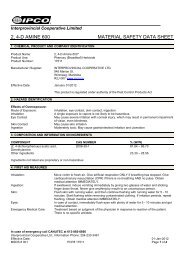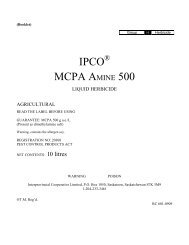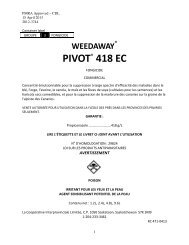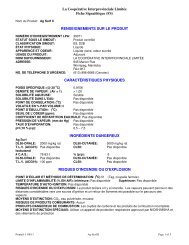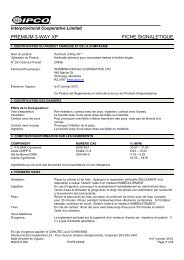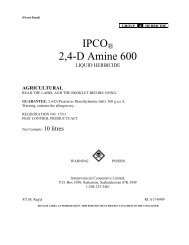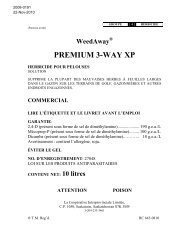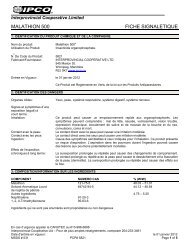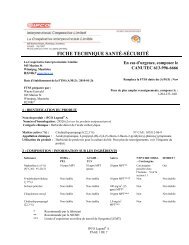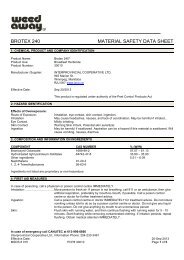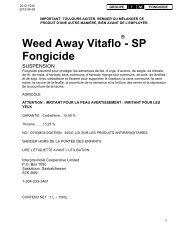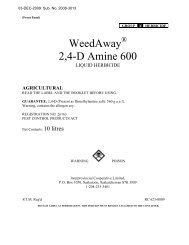Citadel Label - Interprovincial Cooperative Limited (IPCO)
Citadel Label - Interprovincial Cooperative Limited (IPCO)
Citadel Label - Interprovincial Cooperative Limited (IPCO)
Create successful ePaper yourself
Turn your PDF publications into a flip-book with our unique Google optimized e-Paper software.
(Detachable booklet)Group 1B InsecticideCITADEL ® 480 ECINSECTICIDEAGRICULTURALEmulsifiable ConcentrateContains ChlorpyrifosThis product is not to be used in and around homes or other residential areas such as parks, schoolgrounds, playing fields.It is not for use by homeowners or other uncertified users.READ THE LABEL AND BROCHURE BEFORE USINGKEEP OUT OF THE REACH OF CHILDRENGUARANTEE: Chlorpyrifos 480 g/LWarning, contains the allergen soy.REGISTRATION NO. 27479PEST CONTROL PRODUCTS ACTNET CONTENTS: 10 LDANGERPOISONEYE AND SKIN IRRITANT/ POTENTIAL SKIN SENSITIZER<strong>Interprovincial</strong> <strong>Cooperative</strong> <strong>Limited</strong>P.O. Box 1050, Saskatoon, Saskatchewan S7K 3M91-204-233-3461RC# 649-03084
PRECAUTIONSKEEP OUT OF THE REACH OF CHILDRENFATAL OR POISONOUS IF SWALLOWEDHARMFUL IF INHALED OR ABSORBED THROUGH THE SKINCAUSES EYE AND SKIN IRRITATIONPOTENTIAL SKIN SENSITIZERGENERAL PRECAUTIONSDo not get in eyes, on skin or on clothing. Avoid breathing vapour or spray mist. Handle only withadequate ventilation. See Mixer/Loader and Applicator Precautions for protective equipment requirements.Wash thoroughly with soap and water after handling and before eating or smoking. Immediately removecontaminated clothing and wash separately from other laundry before reuse. Destroy contaminated leatherarticles, including shoes. Do not apply this product in such a manner as to directly or through drift exposeworkers or other persons. COMBUSTIBLE. Do not store or use near heat or open flame.If this pest control product is to be used on a commodity that may be exported to the U. S. and you requireinformation on acceptable residue levels in the U. S., visit CropLife Canada’s web site at: www.croplife.ca.FIRST AIDIf in eyes, hold eye open and rinse slowly and gently for 15-20 minutes. Remove contact lenses, if present,after the first 5 minutes, then continue rinsing eye. Contact a poison control centre or a doctor for furtheradvice. If on skin or clothing, take off contaminated clothing. Rinse skin IMMEDIATELY with plenty ofwater for 15-20 minutes. Get medical attention if irritation persists. Call a poison control centre or doctorfor treatment advice. If inhaled, move person to fresh air. If person is not breathing call 911 or anambulance, then give artificial respiration preferably by mouth to mouth resuscitation, if possible. Call apoison control centre or doctor for further treatment advice. If breathing is difficult, give oxygen. If personshows symptoms of choline esterase inhibition (i.e. headache, dizziness, weakness, in-coordination, muscletwitching, tremor, nausea, abdominal cramps, diarrhea, or sweating) or breathing difficulty, get medicalattention or contact a poison control centre IMMEDIATELY. If swallowed, contact a poison control centreIMMEDIATELY for treatment advice. Do not induce vomiting unless told to do so by a poison controlcentre or doctor. Do not give any liquid to the person. Do not give anything by mouth to a person that isunconscious. Take container, label, or product name and Pest Control Product Registration Number withyou when seeking medical attention.TOXICOLOGICAL INFORMATIONChlorpyrifos is an organophosphate that is a cholinesterase inhibitor. Typical symptoms of overexposure tocholinesterase inhibitors include headache, nausea, dizziness, sweating, salivation, runny nose and eyes.This may progress to muscle twitching, weakness and tremor incoordination, vomiting, abdominal crampsand diarrhea in more serious poisonings. A life-threatening poisoning is signified by loss of consciousness,incontinence, convulsions and respiratory depression with a secondary cardiovascular component. Treatsymptomatically. If exposed, plasma and red blood cell cholinesterase tests may indicate degree ofexposure (baseline data are useful). Atropine, only by injection, is the preferable antidote. Oximes, such aspralidoxime chloride, may be therapeutic if used early; however, use only in conjunction with atropine. Incases of severe acute poisoning, use antidotes immediately after establishing an open airway andrespiration. With oral exposure, the decision of whether to induce vomiting or not should be made by anattending physician. NOTE: Product contains a petroleum distillate solvent.ENVIRONMENTAL PRECAUTIONSThis pesticide is toxic to birds and wildlife. This product contains a petroleum distillate which ismoderately to highly toxic to aquatic organisms. Avoid contamination of aquatic systems duringapplication. Drift and runoff from treated areas may be hazardous to aquatic organisms in adjacent aquaticsites. Do not contaminate these systems through direct application, disposal of waste or cleaning5
equipment. Spilled material should be soaked up with absorbent material and disposed of in an approvedmanner.HAZARDSTOXIC to birds, wild mammals and bees exposed to direct treatment, drift, or residues on blooming plants.Do not use on flowering crops or weeds. TOXIC to certain beneficial insects. Minimize spray drift toreduce harmful effects on beneficial insects in habitats next to the application site such as hedgerows andwoodland. DO NOT apply this product or allow it to drift to flowering crops or weeds if bees are visitingthe treatment area. Applicators should inform local bee keepers prior to application if hives are in adjacentfields. Minimize spray drift to reduce harmful effects on bees in habitats close to the application site.To reduce runoff from treated areas into aquatic habitats, consider the characteristics and conditions of thesite before treatment. Site characteristics and conditions that may lead to runoff include, but are not limitedto, heavy rainfall, moderate to steep slope, bare soil, poorly draining soil (e.g., soils that are compacted orfine textured such as clay). Avoid application of this product when heavy rain is forecast. Contamination ofaquatic areas as a result of runoff may be reduced by including a vegetative strip (buffer zone) between thetreated area and the edge of the water body.Buffer Zones for Protection of Aquatic HabitatsFor all applications: DO NOT apply during periods of dead calm. Avoid application of this product whenwinds are gusty.For aerial applications: DO NOT apply when wind speed is greater than 16 km/h at flying height at thesite of application. The nozzle type is restricted to CP ® , with the following set-up restriction:Nozzle typeCP ®RestrictionDO NOT use greater than 30° deflectionBuffer ZonesThe buffer zones specified in the following tables are required between the point of direct application andthe closest downwind edge of sensitive freshwater habitats (such as lakes, rivers, sloughs, ponds, prairiepotholes, creeks, marshes, streams, reservoirs and wetlands), estuarine habitats and marine habitats.Aerial ApplicationsFor all aerial applications, a buffer zone of 100 metres is required for the protection of aquatic habitats.Field Sprayer Applications 1, 2Rate of Application ( L/ha) Buffer Zones (metres) Required for the Protection ofAquatic Habitats with Water Depths Of:< 1 metre 1–3 metre > 3 metreUp to 576 50 40 30Greater than 576 and less than or 55 45 35equal to 1152Greater than 1152 and up to 2304 60 50 401 For field sprayer application, buffer zones can be reduced with the use of drift reducing sprayshields. When using a spray boom fitted with a full shield (shroud, curtain) that extends to thecrop canopy or ground, the labelled buffer zone can be reduced by 70%. When using a sprayboom where individual nozzles are fitted with cone-shaped shields that are no more than 30 cmabove the crop canopy or ground, the labelled buffer zone can be reduced by 30%.2 Buffer zones are not required for treatments applied as a drench (i.e., drench applications forcontrol of cabbage maggot, onion maggot and seedcorn maggot).6
HANDLING PRECAUTIONSMIXER/LOADER PRECAUTIONSFor <strong>Citadel</strong> 480 EC Insecticide packaged in containers holding 10 L or less mixers/loaders must wearcoveralls over a long-sleeved shirt and long pants, chemical-resistant gloves, a chemical-resistant apron,chemical-resistant footwear plus socks and an air purifying respirator with an -R or -P series filter.For <strong>Citadel</strong> 480 EC Insecticide packaged in containers more than 10 L, mixers/loaders must use a closedmechanical transfer loading system and must wear coveralls over a long-sleeved shirt and long pants,chemical-resistant gloves, an air purifying respirator with an -R or -P series filter, and socks and shoes.APPLICATOR PRECAUTIONSDo not apply with high-pressure handwand equipment.Applicators using ground application equipment with a closed cab must wear a long-sleeved shirt and longpants, chemical-resistant gloves when leaving cab for clean up and repair (gloves must be removed whenre-entering the cab) and socks and shoes.Applicators using ground application equipment with an open cab must wear coveralls over a long-sleevedshirt and long pants, chemical-resistant gloves and socks and shoes.Applicators using aerial application equipment must use enclosed cockpits and must wear a long-sleevedshirt and long pants and socks and shoes.Applicators using handheld equipment must wear a long-sleeved shirt and long pants, chemical-resistantcoveralls and head protection (if spray is upwardly directed), chemical-resistant footwear and socks,chemical-resistant gloves and an air purifying respirator with an -R or -P series filter.AERIAL APPLICATION INFORMATIONDIRECTIONS FOR USEApply only by fixed-wing or rotary aircraft equipment which has been functionally and operationallycalibrated for the atmospheric conditions of the area and the application rates and conditions of this label.<strong>Label</strong> rates, conditions and precautions are product specific. Read and understand the entire label beforeopening this product. Apply only at the rate recommended for aerial application on this label. Where norate for aerial application appears for the specific use, this product cannot be applied by any type ofaerial equipment. Ensure uniform application. To avoid streaked, uneven or overlapped application, useappropriate marking devices.AERIAL USE PRECAUTIONSApply only when meteorological conditions at the treatment site allow for complete and even cropcoverage. Apply only under conditions of good practice specific to aerial application, as outlined in theNational Aerial Pesticide Application Manual, developed by the Federal/Provincial/Territorial Committeeon Pest Management and Pesticides. Do not apply to any body of water. Avoid drifting of spray onto anybody of water or other non-target areas. Specified buffer zones should be observed.Coarse sprays are less likely to drift, therefore avoid combinations of pressure and nozzle type that willresult in fine particles (mist). Do not apply during periods of dead calm or when wind velocity anddirection pose a risk of spray drift. Do not spray when the wind is blowing towards a nearby sensitive crop,garden, terrestrial habitat (such as shelterbelt) or aquatic habitat.AERIAL OPERATOR PRECAUTIONSDo not allow the pilot to mix chemicals to be loaded onto the aircraft. Loading of premixed chemicals witha closed system is permitted.It is desirable that the pilot have communication capabilities at each treatment site at the time ofapplication.All personnel on the job site must wash hands and face thoroughly before eating and drinking. Protectiveclothing, aircraft cockpit and vehicle cabs must be decontaminated regularly.7
DIRECTIONS FOR USERead and understand the entire label before opening this product. Economic thresholds are not given on thislabel. Apply <strong>Citadel</strong> 480 EC Insecticide when recommended by provincial authorities and according toprovincial guidelines. If you have questions, call the manufacturer at 1-204-233-3461 or obtain technicaladvice from the distributor or your provincial agricultural representative.<strong>Citadel</strong> 480 EC Insecticide is active against various insect pests as a stomach poison, via contact and byvapor action. It does not exhibit any systemic activity and is of short residual duration when exposed toultraviolet (UV) light in the presence of slight moisture. Residual activity is extended in the absence of UVlight. Treatment of plants that are under extreme drought stress may result in some crop damage.Use the higher rate of <strong>Citadel</strong> 480 EC Insecticide when the surface of the soil to be treated is extremely dryor insect infestations are heavy. Do not incorporate pre-plant soil treatments made to muck soils. Ifpracticed, incorporation in mineral soils should be light (top 5 cm). For foliar applications best results willbe obtained when application is made in early evening. Applications should be broadcast in sufficient waterto give thorough coverage of the intended soil, plant or pest target.Mixing instructions: Add required amount of <strong>Citadel</strong> 480 EC Insecticide into the spray tank two thirdsfilled with the final desired spray volume under agitation. Add the balance of water to fill tank to the finaldesired volume. To maintain a uniform spray mixture, keep agitator running during mixing and application.To avoid phytotoxicity, mix only with other pesticide products or additional adjuvants, surfactants, orspreader stickers recommended on this label.For all broadcast applications of <strong>Citadel</strong> 480 EC Insecticide: DO NOT apply this product directly toaquatic habitats (such as lakes, rivers, sloughs, ponds, prairie potholes, creeks, marshes, streams, reservoirs,ditches and wetlands), estuaries habitats or marine habitats. DO NOT contaminate irrigation or drinkingwater supplies or aquatic habitats by cleaning of equipment or disposal of wastes. Application by aircraft ispermitted only where specified in the directions for use. A plantback interval of 30 days must be observedbetween application and planting of rotational crops, with the exception of radish, Chinese cabbage, pakchoi and cole crops for which no plantback restriction is required.FIELD CROPS (INCLUDING POTATOES)Crops and pestsCANOLABertha armyworm, alfalfalooper, armywormDiamondback moth (larvae)Lygus bugsRates and DirectionsDo not apply more than once per season. Do not apply within 21 days ofharvest. Application is permitted by ground application equipment or aircraftwhere specified. Do not enter treated fields until 1 day after application.Apply 750 mL to 1.0 L in 50–200 L/ha for ground application equipment, orin 10–30 L/ha for aircraft. Apply as a foliar spray. Use the higher rate ofdilution when infestations are heavy and when the foliage is dense. Spray inthe evening to reduce harm to pollinators.Apply 1.0 to 1.5 L in 100–200 L/ha for ground application equipment, or in40 L/ha for aircraft. Apply as a foliar spray. Use the higher rate of dilutionwhen infestations are heavy and when the foliage is dense. Spray in theevening to reduce harm to pollinators.Apply 500 mL to 1.0 L in 50–200 L/ha for ground application equipment, orin 10–30 L/ha for aircraft. Apply as a foliar spray. Use the higher rate ofdilution when infestations are heavy and when the foliage is dense. Spray inthe evening to reduce harm to pollinators.8
Crops and pestsArmy cutworm, darksidedcutworm, pale westerncutworm, redbacked cutworm,variegated cutwormGrasshoppersCEREALS-BARLEY,WHEAT, OATSArmyworm (including berthaarmyworm), army cutworm,darksided cutworm, palewestern cutworm, redbackedcutwormGrasshoppersRates and DirectionsApply 875 mL to 1.2 L in 50–200 L/ha for ground application equipment, orin 10–30 L/ha for aircraft. Apply to the soil or foliage when damage firstappears. When preplant soil applications are being made to muck soil, do notincorporate. Incorporation on mineral soils should be no deeper than 5 cm.Apply 580 to 875 mL in 50–200 L/ha for ground application equipment, orin 10–30 L/ha for aircraft. Apply as a foliar spray. Use the low rate for thecontrol of juvenile grasshoppers and the high rate for the control of adultgrasshoppers. Adjacent ungrazed and unoccupied areas such as roadsides,rights-of-way and fence lines should be treated at the first sign of infestation.Do not apply more than once per season to barley or wheat. Do not applywithin 60 days of harvest. Application is permitted by ground applicationequipment or aircraft where specified. Do not enter treated fields until 1 dayafter application. Applications should be made when temperatures exceed15°C and wind speed is less than 10 kph during late afternoon or earlyevening. For more information, contact your local district agriculturalrepresentative.Apply 875 mL to 1.2 L in 50–200 L/ha for ground application equipment orin 10–30 L/ha for aircraft. Apply to soil or foliage when damage firstappears. When preplant soil applications are being made to muck soil, do notincorporate. Incorporation on mineral soils should be no deeper than 5 cm.Apply 580 mL to 875 mL in 50–200 L/ha for ground application equipment,or in 10–30 L/ha for aircraft. Apply as a broadcast foliar spray. Use the lowrate for juvenile grasshoppers and the high rate for adults. Treat adjacentungrazed and unoccupied areas such as roadsides, rights-of-way and fencelines at the first sign of infestation.Brown wheat mite Apply 625 mL in 50–200 L/ha for ground application equipment or in 10–30Russian wheat aphidOrange wheat blossom midge(WHEAT only)L/ha for aircraft. Apply as a foliar spray.Apply 500 mL in a minimum of 100 L/ha for ground application equipmentor in a minimum of 20 L/ha for aircraft. Apply as a foliar spray.Apply 830 mL to 1.0 L in 50–200 L/ha for ground application. Apply 1.0 Lin 10–30 L/ha for aerial application. Apply when adults reach the economicthreshold and when 25% of the wheat heads have emerged from the boot, butpreferably delay spraying until 30% of the crop is flowering. Timing iscritical to ensure good control. Applications should be made in the lateafternoon or early evening when temperatures exceed 15°C and wind speedis less than 10 km/h.CORN (FIELD, SWEET) Do not apply more than 1 application per season. Do not apply within 70days of harvest. Ground application only (DO NOT APPLY BYAIRCRAFT). Do not enter treated fields until 1 day after application.Black cutworm, darksidedcutworm, redbacked cutwormSOIL TREATMENT (PREPLANTING)Apply 2.4 L in 200–400 L/ha. Apply once as a soil treatment 3–7 days beforeplanting. Do not incorporate. Also apply to a 15 m strip into adjacent fencerows.SEEDLING TREATMENTApply 1.2 to 2.4 L in 200–400 L/ha. Apply once as a broadcast spray at the2- to 5-leaf stage of the crop.9
Crops and pestsSUNFLOWERArmy cutworm, pale westerncutworm, redbacked cutwormSeed weevilTOBACCOBlack cutworm, darksidedcutworm, redbacked cutwormDarksided cutwormRates and DirectionsApplication is permitted by ground application equipment or aircraft wherespecified. Do not apply more than once per season. Do not apply within 42days of harvest. Do not enter treated fields until 1 day after application.Ground application only (DO NOT APPLY BY AIRCRAFT). Apply 1.2 Lin 50–200 L/ha. Apply as a broadcast spray when damage first appears.When preplant soil applications are being made to muck soil, do notincorporate. Incorporation on mineral soils should be no deeper than 5 cm.Ground or aerial application. Apply 1.2 L in at least 20 L/ha. Apply in lateJuly to early August when populations of weevils are observed in thesunflower heads.Do not apply more than once per season. Ground application only (DO NOTAPPLY BY AIRCRAFT). Do not enter treated fields until 1 day afterapplication.SOIL TREATMENT: Apply 2.4 to 4.8 L in 200–400 L/ha. Apply once, 3–7days before planting or transplanting. If the top 1 cm or more of soil is dry,use the higher rate. When preplant soil applications are being made to mucksoil, do not incorporate. Incorporation on mineral soils should be no deeperthan 5 cm. Also apply to a 15 m strip into adjacent cover crop and to fencerows.COVER CROP TREATMENT : Apply 1.125 to 1.2 L in 200–400 L/ha.Darksided cutworms may feed on the cover crop before spring plough-down.Apply to the area planted to tobacco and to a strip about 15 m into nearbycover crop and fence rows. Application should be made in mid to late April,4 to 5 days before plough-down. When the rye cover crop is about 15 cm tall,the cutworm larvae will be at the right stage for the best control. Cerealsgrown for cover crop treated with this insecticide should not be used forhuman or animal consumption if treated within 60 days of harvest.FRUIT AND VEGETABLE CROPSCrops and pestsCARROTBlack cutworm, darksidedcutworm, redbacked cutwormRates and DirectionsGround application only (DO NOT APPLY BY AIRCRAFT). Do not applymore than once per season. Do not apply within 60 days of harvest. Do notenter treated fields until 1 day after application.SOIL TREATMENT: Apply 2.4 TO 4.8 L in 200–400 L/ha. Apply once perseason before planting or transplanting. May also be applied to a 15 m stripadjacent to fence rows. Use the low rate except under conditions of low soilmoisture. Use the high rate if the top 1 cm of soil is dry. When preplant soilapplications are being made to muck soil, do not incorporate. Incorporationon mineral soils should be no deeper than 5 cm.SEEDLING TREATMENT: Apply 2.4 to 4.8 L in 200–400 L/ha. Apply as abroadcast spray at the 2- to 5-leaf stage. Use the low rate except underconditions of low soil moisture. Use the high rate if the top 1 cm of soil isdry.11
Crops and pestsCELERY, CUCUMBER,PEPPER (GREEN)Black cutworm, darksidedcutworm, redbacked cutwormCABBAGE, CAULIFLOWER,BROCCOLI, BRUSSELSPROUT, PAK CHOI,CHINESE CABBAGECabbage maggotBlack cutworm, darksidedcutworm, redbacked cutworm(for BROCCOLI, BRUSSELSPROUTS, CABBAGE,CAULIFLOWER, CHINESECABBAGE)GARLICOnion maggotBlack cutworm, darksidedcutworm, redbacked cutwormRates and DirectionsDo not apply more than once per season. Do not apply within 70 days ofharvest for celery, 40 days of harvest for pepper, or 60 days of harvest forcucumber. Ground application only (DO NOT APPLY BY AIRCRAFT). Donot enter treated fields until 1 day after application.SOIL TREATMENT: Apply 2.4 L in 200–400 L/ha.Apply once as a soil treatment 3–7 days before planting or transplanting. Donot incorporate. Also apply to a 15 m strip into adjacent fence rows.SEEDLING TREATMENT: Apply 1.2 to 2.4 L in 200–400 L/ha. Applyonce as a broadcast spray at the 2- to 5-leaf stage of the crop.Ground application only (DO NOT APPLY BY AIRCRAFT). Do not entertreated fields until 1 day after application for pak choi and Chinese cabbages.Do not enter treated fields until 10 days after application for cauliflower, 1day after application for all other crops. [See also below.]If no granular chlorpyrifos treatment has been used, do not apply more thantwice per season to broccoli, cabbages, cauliflower, Chinese cabbages andpak choi, or three times per season to Brussels sprouts. If granular treatmenthas been used, do not apply more than once per season to broccoli, cabbages,cauliflower, Chinese cabbages and pak choi, or twice per season to Brusselssprouts. Do not apply within 32 days of harvest for broccoli, Brusselssprouts, cabbages, cauliflower or Chinese cabbages; or within 15 days ofharvest for pak choi.AT-PLANTING TREATMENT: Apply 210 mL/1000 m of row. Apply onedrench spray in 1000 L/ha spray solution, 10 cm on each side of the plant, 7–10 days after seeding or 3 days after transplanting.POST PLANTING DRENCH: Mix 1.7 L in enough water to make 1000 Lof finished spray. Apply 12.5 L of this solution per 100 m of row on soil, 10cm on each side of the plant. Do not apply to harvestable portions of thecrop.If no granular treatment was used at seeding: For broccoli, Brusselsprouts, cabbages and cauliflower, apply a drench treatment within 3 days oftransplanting (after plant recovery) or 7–10 days after seeding. Repeat 21days after the transplanting drench or 28 days after the seeding drench.SOIL TREATMENT: Apply 2.4 L in 200–400 L/ha. Apply once, 3–7 daysbefore transplanting. Do not incorporate. Also apply to a 15 m strip intoadjacent fence rows.SEEDLING TREATMENT: Apply 1.2 to 2.4 L in 200–400 L/ha. Applyonce as a broadcast spray at the 2- to 5-leaf stage of the crop.Do not apply more than twice per season. Do not apply within 50 days ofharvest. Ground application only (DO NOT APPLY BY AIRCRAFT). Donot enter treated fields until 1 day after application.Apply 3.5 L in 1000 L/ha. Apply as a drench to the soil over the seedlingrow.SOIL TREATMENT: Apply 2.4 L in 200–400 L/ha. Apply once, 3–7 daysbefore transplanting. Do not incorporate. Also apply to a 15 m strip intoadjacent fence rows.SEEDLING TREATMENT: Apply 1.2 to 2.4 L in 200–400 L/haApply once as a broadcast spray at the 2- to 5-leaf stage of the crop. Apply asa broadcast spray when damage first appears to the crop at the 2 to 5 leafstage.12
Crops and pestsONION (bulb, pickling)Black cutworm, darksidedcutworm, redbacked cutwormSTRAWBERRYStrawberry cutworm (crownborer)RUTABAGABlack cutworm, darksidedcutworm, redbacked cutwormCabbage maggotRates and DirectionsGround application only (DO NOT APPLY BY AIRCRAFT). Do not applymore than once per season. Do not enter treated fields until 1 day afterapplication. Do not apply to bunching onions. [See also below.] Do not applywithin 60 days of harvest.SOIL TREATMENT: Apply 2.4 to 4.8 L in 200–400 L/ha. Apply once perseason before planting or transplanting. Application is also permitted on a 15m strip adjacent to fence rows. Use the low rate except under conditions oflow soil moisture. Use the high rate if the top 1 cm of soil is dry. Whenpreplant soil applications are being made to muck soil, do not incorporate.Incorporation on mineral soils should be no deeper than 5 cm.SEEDLING TREATMENT: Apply 2.35 to 4.80 L in 200–400 L/ha. Applyas a broadcast spray at the 2- to 5-leaf stage. Use the low rate except underconditions of low soil moisture. Use the high rate if the top 1 cm of soil isdry.Do not apply more than once per season. Ground application only (DO NOTAPPLY BY AIRCRAFT). Do not apply within 20 days of harvest. Do notenter treated fields until 1 day after application.Apply 1.17 to 1.20 L in 2000 L/ha. Apply once as a foliar spray betweenJune 1 and June 15. Large volumes of water are desirable to ensure fullwetting of the crown area of the plants.Ground application only (DO NOT APPLY BY AIRCRAFT). Do not entertreated fields until 1 day after application. Do not apply within 30 days ofharvest. [See also below.]If no granular chlorpyrifos treatment has been used, do not apply more than4 times per season. If granular chlorpyrifos treatment has been used, do notapply more than 3 times per season.SOIL TREATMENT: Apply 2.4 L in 200–400 L/ha. Apply once, 3–7 daysbefore transplanting. Do not incorporate. Also apply to a 15 m strip intoadjacent fence rows.SEEDLING TREATMENT: Apply 1.2 to 2.4 L in 200–400 L/ha. Applyonce as a broadcast spray at the 2- to 5-leaf stage of the crop.Apply 210 mL in 125 L/1000 m row. Apply as a postplanting drench to soil,10 cm on each side of the plant. Application rates for different row spacingsare as follows:Row SpacingL/ha30 cm 7.0060 cm 3.5075 cm 2.8080 cm 2.6390 cm 2.33105 cm 2.00Do not apply to harvestable portions of the crop. If no granular treatment wasused at seeding, apply drench treatments at 10, 28, 49 and 70 days afterseeding. If granular treatment with a chlorpyrifos insecticide was used atseeding, apply drench treatments at 28, 49 and 70 days after seeding.13
NOTE TO USER: READ THE FOLLOWING BEFORE USING THIS PRODUCT FOR SPECIAL USEAPPLICATIONS: (ASIAN RADISH, RADISH, CHINESE BROCCOLI, FILBERT).The DIRECTIONS FOR USE for this product described on the label were developed by persons other than<strong>Interprovincial</strong> <strong>Cooperative</strong> <strong>Limited</strong> and accepted for registration by Health Canada under the User RequestedMinor Use <strong>Label</strong> Expansion program. <strong>Interprovincial</strong> <strong>Cooperative</strong> <strong>Limited</strong> itself makes no representation orwarranty with respect to performance (efficacy) and/or crop tolerance (phytotoxicity) claims for this productwhen used on the crop listed on this label. Accordingly, the Buyer and User assume all liability arising, andagree to hold <strong>Interprovincial</strong> <strong>Cooperative</strong> <strong>Limited</strong> harmless from any claims based on efficacy and/orphytotoxicity in connection with the uses described on this label.DIRECTIONS FOR USEASIAN RADISH (LO BOK,DAIKON)Cabbage maggotRADISHCabbage maggotCHINESE BROCCOLICabbage maggotFILBERTFilbert aphidDo not apply more than 3 times per season. Ground application only(DO NOT APPLY BY AIRCRAFT). Do not apply within 32 daysof harvest. Do not enter treated fields until 1 day after application.Apply 210 mL in 1000 L of water per 1000 m row. Apply as adrench over seeded rows at 7, 20 and 35 days after seeding.Do not apply more than once per season. Ground application only(DO NOT APPLY BY AIRCRAFT). Do not apply within 21 daysof harvest. Do not enter treated fields until 1 day after application.Apply 85 mL in 380 L of water per 1000 m row. Apply as a drenchwith seed at planting time.Do not apply more than once per season. Ground application only(DO NOT APPLY BY AIRCRAFT). Do not apply within 21 daysof harvest. Do not enter treated fields until 1 day after application.Apply 150 mL in 800 L/1000 m row. Apply once per season bandedover the row 5–7 days after seeding.Do not apply more than three times per season. Do not apply within14 days of harvest. Ground application only (DO NOT APPLY BYAIRCRAFT). Do not enter treated fields until 4 days afterapplication to conduct scouting activities.Apply 4.2 to 4.8 L in 100 L/ha. Apply as a foliar spray with groundapplication only using an airblast sprayer. Direct nozzles of air blastsprayer into the orchard when spraying border rows.ALWAYS REFER TO THE PRODUCT LABEL FOR FURTHER INFORMATION ON PESTSCONTROLLED, APPLICATION DIRECTIONS, AND OTHER USE PRECAUTIONS.14
FORESTRY: Lodgepole PineMountain pine beetleRESTRICTED USEGround application only (DO NOT APPLY BY AIRCRAFT). Foruse in Western Canada only.NATURE OF RESTRICTION: This product is to be used only in themanner authorized. Contact local pesticide regulatory authoritiesabout appropriate use permits that may be required.To be applied only under the direct supervision of commercialapplicator responsible for insect control programs.For ground use only to control small infestations of mountain pinebeetle in lodgepole pine forest stands. Monitor stands from mid-Juneto mid-July to determine the trees that are infested. Treated infestedtrees within a few weeks of expected beetle emergence, usually earlyJuly, to kill the adult beetles. Avoid spraying when conditions favourdrift from spray area.Prepare a spray solution of 41.7 L /1000 L of water to make a spraycontaining 2% active ingredient by weight. Apply at a rate of 1 Lspray /m 2 of bark prior to adult beetle emergence. Treat boles fromground level up to a height of at least 3 m or until a bole diameter of12.5 cm is reached.ALWAYS REFER TO THE PRODUCT LABEL FOR FURTHER INFORMATION ON PESTSCONTROLLED, APPLICATION DIRECTIONS, AND OTHER USE PRECAUTIONS.TANK MIX COMBINATIONS WITH HERBICIDES<strong>Citadel</strong> 480 EC Insecticide can be tank mixed with the herbicides listed below for wheat, oats, and barley.The mixture will control insect pests as well as broadleaved or grassy weeds as recommended on the labelsof the product used. Read carefully and follow all use directions and use precautions on both the<strong>Citadel</strong> 480 EC Insecticide label and the label of the herbicide to be used for tank mixing. Failure tofollow the rates of use and timing of application as recommended for each product will result inunsatisfactory control of the insect or weed target pest. When tank mixing, always follow the morerestrictive warnings and precautions found on either product label.When tank mixing <strong>Citadel</strong> 480 EC Insecticide with the following herbicides, always add the herbicide tothe spray tank first and then add the <strong>Citadel</strong> 480 EC Insecticide. Addition of the <strong>Citadel</strong> 480 EC Insecticidefirst could result in product precipitation in the tank and sprayer plugging, resulting in poor control.Avenge* 200-CBanvel II* plus 2,4-D AmineLogic* MMCPA EsterMCPA AmineBuctril* M2,4-D Ester2,4-D Amine* Trade Marks of the Respective Registrants/OwnersRESISTANCE MANAGEMENTFor resistance management, please note that <strong>Citadel</strong> 480 EC Insecticide contains a Group 1B insecticide.Any insect population may contain individuals naturally resistant to <strong>Citadel</strong> 480 EC Insecticide and otherGroup 1B insecticides. The resistant individuals may dominate the insect population if this group ofinsecticides are used repeatedly in the same fields. Other resistance mechanisms that are not linked to siteof action but are specific for individual chemicals, such as enhanced metabolism, may also exist.Appropriate resistance-management strategies should be followed.To delay insecticide resistance: Where possible, rotate the use of <strong>Citadel</strong> 480 EC Insecticide or other Group1B insecticides with different groups that control the same pests, in a field. Use tank mixtures withinsecticides from a different group when such use is permitted. Insecticide use should be based on an IPMprogram that includes scouting, record keeping, and considers cultural, biological and other chemical15
control practices. Monitor treated pest populations for resistance development. Contact your local extensionspecialist or certified crop advisors for any additional pesticide resistance-management and/or IPMrecommendations for the specific site and pest problems in your area. For further information or to reportsuspected resistance contact <strong>Interprovincial</strong> <strong>Cooperative</strong> <strong>Limited</strong> at 1-204-233-3461.STORAGEDo not contaminate water, food or feed by storage or disposal of wastes. Protect from moisture. Avoidstorage at high temperatures. Avoid contamination with water, acids or alkalines. Do not store near heat oropen flame. Keep container closed.DISPOSALDo not reuse this container for any purpose. This is a recyclable container, and is to be disposed of at acontainer collection site. Contact your local distributor/dealer or municipality for the location of the nearestcollection site. Before taking the container to the collection site:1. Triple- or pressure-rinse the empty container. Add the rinsings to the spray mixture in the tank.2. Make the empty, rinsed container unsuitable for further use.If there is no container collection site in your area, dispose of the container in accordance with provincialrequirements. For information on disposal of unused, unwanted product, contact the manufacturer or theprovincial regulatory agency. Contact the manufacturer and the provincial regulatory agency in case of aspill, and for clean-up of spills.NOTICE TO USERThis pest control product is to be used only in accordance with the directions on the label. It is an offenceunder the Pest Control Products Act to use this product in a way that is inconsistent with the directions onthe label. The user assumes the risk to persons or property that arises from any such use of this product.16
(Base label)Group1B InsecticideCITADEL ® 480 ECINSECTICIDEAGRICULTURALEmulsifiable ConcentrateContains ChlorpyrifosThis product is not to be used in and around homes or other residential areas such as parks, schoolgrounds, playing fields.It is not for use by homeowners or other uncertified users.READ THE LABEL AND BROCHURE BEFORE USINGKEEP OUT OF THE REACH OF CHILDRENGUARANTEE: Chlorpyrifos 480 g/LWarning, contains the allergen soy.REGISTRATION NO. 27479PEST CONTROL PRODUCTS ACTNET CONTENTS: 10 LDANGERPOISONEYE AND SKIN IRRITANT/POTENTIAL SKIN SENSITIZER<strong>Interprovincial</strong> <strong>Cooperative</strong> <strong>Limited</strong>P.O. Box 1050, Saskatoon, Saskatchewan S7K 3M91-204-233-3461RC# 649-030817



